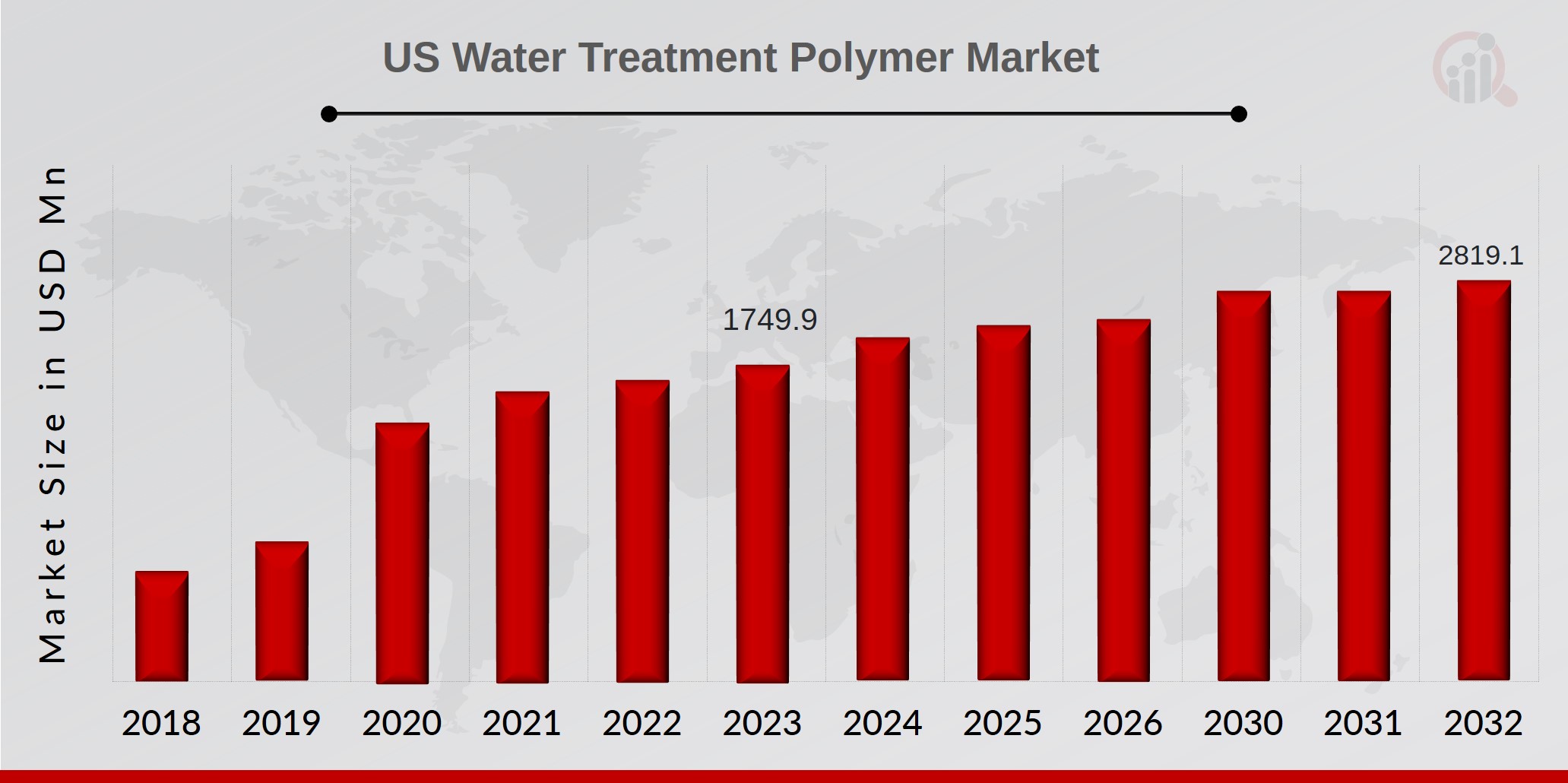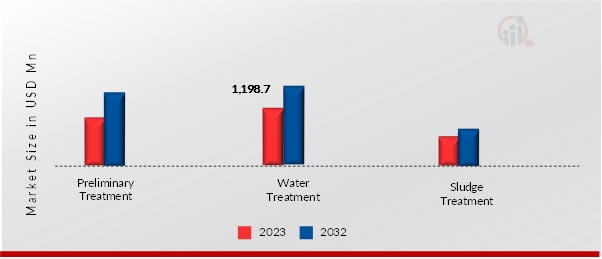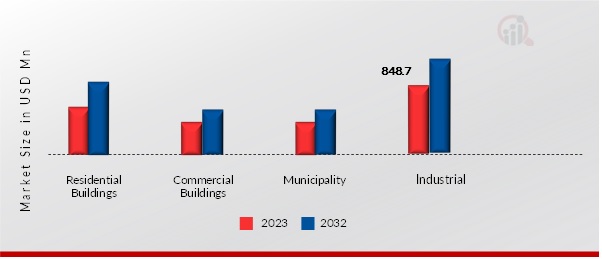Us Water Treatment Polymer Market Overview
US Water Treatment Polymer Market Size was valued at 1749.9 USD Million in 2023. The Water Treatment Polymer Market industry is projected to grow from USD 1844.2 USD Million in 2024 to USD 2819.1 Million by 2032, exhibiting a compound annual growth rate (CAGR) of 5.4% during the forecast period (2024 - 2032).
Water treatment polymers are chemical compounds used in the process of treating water by improving the efficiency of various treatment steps, such as coagulation, flocculation, sedimentation, and dewatering. These polymers are typically synthetic or natural molecules that act as flocculants or coagulants, helping to aggregate and remove suspended particles, organic matter, and other impurities from water. In water treatment systems, they are crucial for purifying drinking water, wastewater, and industrial effluents, ensuring the treated water meets safety standards. Polymers also assist in sludge management by enhancing the dewatering process, reducing waste volume and facilitating easier disposal. Their use helps improve water quality, enhance operational efficiency, and comply with environmental regulations.

Source: Secondary Research, Primary Research, MRFR Database and Analyst Review
Water Treatment Polymer Market Trends
INCREASING WATER POLLUTION AND CONTAMINATION
Increasing water pollution and contamination are key drivers for the growth of the U.S. water treatment polymer market. As industrial activities, urbanization, and agricultural practices continue to introduce harmful contaminants into water systems, the need for advanced water treatment solutions is escalating. Water treatment polymers, which are used in processes such as coagulation, flocculation, and filtration, play a critical role in removing pollutants and improving the quality of water. Polymers help in the efficient removal of suspended solids, organic matter, and pathogens, making them essential in both municipal and industrial water treatment systems.
In the United States, various factors contribute to water contamination, including agricultural runoff containing pesticides and fertilizers, untreated industrial effluents, and the leaching of heavy metals and other toxins from aging infrastructure. As a result, approximately 50% of U.S. lakes and rivers are deemed too polluted for recreational activities such as swimming and fishing, or for safe drinking. In response to these challenges, municipalities and industries are increasingly turning to advanced water treatment polymers to meet regulatory standards and ensure the delivery of clean, safe water for both public consumption and ecological health. These polymers play a critical role in enhancing water purification processes, helping to mitigate the impact of pollution and safeguard water quality.
The growing public concern over contaminated drinking water is driving an increased demand for effective water treatment solutions, particularly water treatment polymers. As both consumers and municipalities become more proactive in addressing water safety, the need for advanced purification technologies has intensified. Polymers play a critical role in water filtration and purification processes by mitigating contamination from sources such as agricultural runoff, industrial effluents, and aging infrastructure. This rising awareness of water quality issues not only leads to more stringent regulatory standards but also accelerates the expansion of the U.S. water treatment polymer market. As industries and municipalities seek innovative and reliable solutions to ensure the provision of clean, safe drinking water, the adoption of water treatment polymers is expected to continue its upward trajectory, supporting efforts to address both current and emerging water quality challenges.
One prominent example of this trend is the growing demand for polyacrylamide (PAM), a water treatment polymer widely used in wastewater treatment. In municipal settings, PAM is used to remove suspended solids and facilitate the separation of solid waste from treated water. In industrial settings, it is used in processes such as oil and gas wastewater treatment, where it helps in the efficient removal of contaminants like oil, grease, and heavy metals. As pollution levels rise, the market for such polymers has expanded, driven by stricter environmental regulations and the need for more efficient treatment methods. Thus, the growing urgency to tackle water contamination has led to increased investment in water treatment polymers, creating a dynamic market in the U.S. that continues to expand as water pollution remains a pressing concern.
GROWING INDUSTRIALIZATION AND URBANIZATION
The growing industrialization and urbanization are key drivers for the U.S. water treatment polymer market. As industries continue to expand and urban areas grow in size and population, the demand for efficient water treatment solutions has increased, thus boosting the use of water treatment polymers. These polymers play a crucial role in enhancing water purification processes, particularly in removing contaminants and improving water quality. They are employed in a range of processes, including coagulation, flocculation, filtration, and sludge dewatering, which are critical for maintaining the safety and sustainability of water supplies, especially in urbanized and industrial regions.
In urban areas, population growth leads to a higher demand for potable water and efficient wastewater treatment systems. This has prompted municipalities to upgrade existing infrastructure or build new plants to accommodate the growing water demand. For example, in cities like Los Angeles, California, where the population continues to increase, the water treatment plants use water treatment polymers to improve the efficiency of their wastewater treatment processes. The polymers help to remove particles, organic matter, and chemicals from the water, ensuring that they meet safety standards. Similarly, large industrial operations, such as in the oil and gas, paper, and textile industries, also require water treatment solutions to handle the wastewater generated from manufacturing processes. In these industries, water treatment polymers help manage industrial effluents, reduce water pollution, and comply with environmental regulations.
As industrialization continues to advance, there is an ever-growing emphasis on sustainability and adherence to stringent environmental regulations across various sectors. Water treatment polymers have become a vital component in this effort, playing a crucial role in enhancing the efficiency of water recovery processes and reducing the environmental impact of industrial wastewater. These polymers are particularly valuable in industries such as mining, where water is often contaminated with heavy metals, chemicals, and other toxic substances. By utilizing specialized water treatment polymers, mining operations can effectively remove contaminants, purify water, and enable its reuse within the system. This not only helps minimize the environmental footprint of mining activities but also contributes to resource conservation by reducing the demand for fresh water. The addition to mining, water treatment polymers are also employed in other industries like manufacturing, oil and gas, and agriculture, where they help in managing wastewater, meeting regulatory requirements, and promoting the sustainable use of water resources. With increasing pressure to adopt greener technologies, the role of water treatment polymers in reducing pollution and fostering sustainability will only continue to grow.
Overall, industrialization and urbanization have significantly accelerated the demand for water treatment solutions in the U.S. By enabling more efficient and sustainable water treatment processes, water treatment polymers have become a vital component in addressing the challenges posed by growing populations and industrial activities.
ADOPTION OF ECO-FRIENDLY AND BIODEGRADABLE POLYMERS
The adoption of eco-friendly and biodegradable polymers presents a significant opportunity for the U.S. water treatment polymer market, driven by growing environmental concerns and regulatory pressure to reduce the ecological impact of traditional chemical treatments. These alternative polymers offer advantages in terms of sustainability and reduced toxicity, making them ideal for industries looking to enhance their environmental credentials while maintaining effective water purification processes. As the U.S. moves toward more sustainable practices in water management, the demand for biodegradable and eco-friendly polymers is expected to grow, presenting both challenges and opportunities for manufacturers, water treatment plants, and policymakers.
One of the primary drivers behind the shift toward eco-friendly and biodegradable polymers is the increasing emphasis on environmental sustainability. Traditional water treatment chemicals, such as polyacrylamide-based flocculants, while effective, have raised concerns due to their potential environmental impact. These conventional polymers can persist in the environment, leading to the accumulation of microplastics and other harmful residues in aquatic ecosystems. In contrast, biodegradable polymers are designed to break down more quickly after use, reducing the long-term environmental footprint of water treatment processes.
In response to these concerns, regulatory bodies like the U.S. Environmental Protection Agency (EPA) have been encouraging industries to adopt greener alternatives. Regulations such as the Clean Water Act and the National Pollutant Discharge Elimination System (NPDES) permit processes are pushing industries to consider more sustainable solutions for water treatment. The U.S. government’s growing focus on addressing water pollution and promoting sustainability in industrial operations is creating a market for alternative polymer solutions.
Technological advancements have played a critical role in making eco-friendly polymers more viable for the water treatment industry. One notable example is the development of biodegradable copolymers and natural polymer-based flocculants, which offer enhanced performance with less environmental impact. For instance, polysaccharides like xanthan gum, guar gum, and chitosan are being explored as biodegradable alternatives to synthetic polymers. These natural polymers have been shown to effectively aid in coagulation and flocculation, processes crucial in water purification and wastewater treatment.
Another promising development is the use of bio-based polyesters, such as poly (lactic acid) (PLA), which are derived from renewable resources like corn or sugarcane. PLA has found applications in water treatment due to its ability to biodegrade in aquatic environments, offering an environmentally friendly option for coagulation and flocculation in municipal and industrial wastewater treatment facilities.
Several companies in the U.S. have already embraced the shift toward biodegradable and eco-friendly polymers in their water treatment processes. For example, Solvay, a chemicals and plastics manufacturer, has developed a line of sustainable, biodegradable water treatment polymers that are used in both municipal and industrial applications. These polymers are designed to reduce environmental contamination and improve the efficiency of water purification processes.
Water Treatment Polymer Market Segment Insights
Water Treatment Polymer by Product Type Insights
The US Water Treatment Polymer Market segmentation, based on Product Type has been segmented as Polyacrylamides, Polyacrylates and Polyacrylates. Among these, the Polyacrylamides segment is projected to dominate the US Water Treatment Polymer market revenue through the projected period. Polyacrylamides (PAMs) are one of the most widely used water treatment polymers due to their exceptional ability to flocculate or agglomerate particles in water, improving the efficiency of solid-liquid separation. These polymers are extensively employed in both municipal and industrial water treatment applications, including drinking water purification, wastewater treatment, and sludge dewatering. Polyacrylamides work by creating a sticky surface charge that binds particles together, which are then removed through sedimentation or filtration. Additionally, PAMs are used in the oil and gas industry for water-based drilling fluids and enhanced oil recovery processes. The versatility of polyacrylamides in reducing turbidity, improving filtration efficiency, and aiding in the clarification of water has made them indispensable in the treatment of both raw and wastewater.
Water Treatment Polymer by Product Type, 2023, 2032 (USD Million)

Water Treatment Polymer by Application Insights
Based on Application, the US Water Treatment Polymer Market is segmented as Preliminary Treatment, Water Treatment and Sludge Treatment. Out of which the Water Treatment Applications segment dominated base year market and is also projected to dominate the US Water Treatment Polymer market revenue through the projected period. Water treatment is the core process that focuses on improving water quality to meet safety standards for consumption or discharge into the environment. It typically involves filtration, chemical treatment, disinfection, and sometimes reverse osmosis. Water treatment polymers are essential for optimizing these processes, particularly in coagulation, flocculation, and filtration stages. Polymers are used to bind particles together, making it easier to remove contaminants like microorganisms, heavy metals, organic matter, and dissolved solids. Additionally, polymers improve the efficiency of filtration systems, helping to maintain a consistent flow of treated water while minimizing the operational costs of the treatment plant. The demand for high-performance polymers that can treat a wide range of contaminants is increasing due to stricter regulatory requirements and a growing need for water sustainability.
Water Treatment Polymer by Application, 2023, 2032 (USD Million)

Water Treatment Polymer by End User Insights
The US Water Treatment Polymer Market segmentation, based on End User has been segmented as Residential Buildings, Commercial Buildings, Municipality and Industrial. Among these, the Industrial segment held the maximum market share and is also expected to account for the significant revenue share during the forecast period. The industrial sector is one of the largest consumers of water treatment polymers due to the heavy water usage across various industries such as manufacturing, power generation, mining, and food processing. These polymers are used in a wide range of processes, including water recycling, cooling, and wastewater treatment. Industries use water treatment polymers to prevent scale and corrosion in cooling towers, improve the efficiency of filtration systems, and treat industrial effluents before discharging them into the environment. Additionally, polymers are essential for controlling microbial growth, enhancing water quality, and ensuring that industrial processes run smoothly without damaging equipment. As industries face increasing environmental regulations and strive for sustainability, the demand for water treatment polymers to manage water usage, treatment, and disposal is expected to grow.
Water Treatment Polymer by End User Insights, 2023, 2032 (USD Million)

Water Treatment Polymer Key Market Players & Competitive Insights
The US water treatment polymer market is a competitive and fragmented industry characterized by the presence of both multinational corporations and specialized regional players. The market serves a broad spectrum of applications including municipal water treatment, industrial water treatment, and wastewater management. Major global players in the market include Hydrite Chemical Co., Nouryon, Kemira, SNF, and Arkema, which hold significant market shares due to their established brands, extensive product portfolios, and robust distribution networks. These companies offer a wide range of water-soluble polymers, including flocculants, coagulants, dispersants, and scale inhibitors, designed to improve the efficiency of water treatment processes.
The competition is driven by a combination of factors such as technological innovation, cost-efficiency, and regulatory compliance. For instance, companies are increasingly focusing on developing sustainable and biodegradable polymer solutions to align with stricter environmental regulations and rising consumer demand for eco-friendly products. Innovations in polymer chemistry, such as the development of high-performance, low-dose formulations, have also allowed players to differentiate themselves in the market.
Key Companies in the Water Treatment Polymer Market includes
- Hydrite Chemical Co.
- Nouryon
- Kemira
- SNF
- Arkema
- Aries Chemical, Inc.
Water Treatment Polymer Market Segmentation
Water Treatment Polymer Product Type Outlook
- Polyacrylamides
- Polyacrylates
- Polyacrylates
Water Treatment Polymer Rated Application Outlook
- Preliminary Treatment
- Water Treatment
- Sludge Treatment
Water Treatment Polymer End User Outlook
- Residential Buildings
- Commercial Buildings
- Municipality
- Industrial
|
Report Attribute/Metric
|
Details
|
|
Market Size 2023
|
USD 1749.9 Million
|
|
Market Size 2024
|
USD 1844.2 Million
|
|
Market Size 2032
|
USD 2819.1 Million
|
|
Compound Annual Growth Rate (CAGR)
|
5.4% (2024-2032)
|
|
Base Year
|
2023
|
|
Forecast Period
|
2024-2032
|
|
Historical Data
|
2018 & 2022
|
|
Forecast Units
|
Value (USD Million)
|
|
Report Coverage
|
Revenue Forecast, Competitive Landscape, Growth Factors, and Trends
|
|
Segments Covered
|
Product Type, Application and End User
|
|
Key Companies Profiled
|
Hydrite Chemical Co., Nouryon, Kemira, SNF, Arkema and Aries Chemical, Inc.
|
|
Key Market Opportunities
|
· Adoption of Eco-friendly and Biodegradable Polymers
|
|
Key Market Dynamics
|
· Increasing Water Pollution and Contamination
· Growing Industrialization and Urbanization
|
Frequently Asked Questions (FAQ) :
Hydrite Chemical Co., Nouryon, Kemira, SNF, Arkema and Aries Chemical, Inc.
The US Water Treatment Polymers Market is expected to be valued at 7.5 billion USD in 2024.
By 2035, the market is projected to reach a valuation of 14.5 billion USD.
The expected CAGR for the US Water Treatment Polymers Market from 2025 to 2035 is 6.176%.
In 2024, Quaternary Ammonium Polymers hold a leading position in the market, valued at 3.0 billion USD.
Polyacrylamides are valued at 2.5 billion USD in the market for the year 2024.
Key players include Feral Co., Baker Hughes, Kemira, and Ecolab among others in the market.
The expected market value of Polyacrylates is projected to reach 3.8 billion USD by 2035.
The market may face challenges such as regulatory changes and environmental concerns affecting polymer usage.
Key applications driving growth include municipal water treatment, industrial wastewater treatment, and oil and gas operations.
Emerging opportunities include advancements in polymer technology and increasing demand for sustainable water treatment solutions.


















